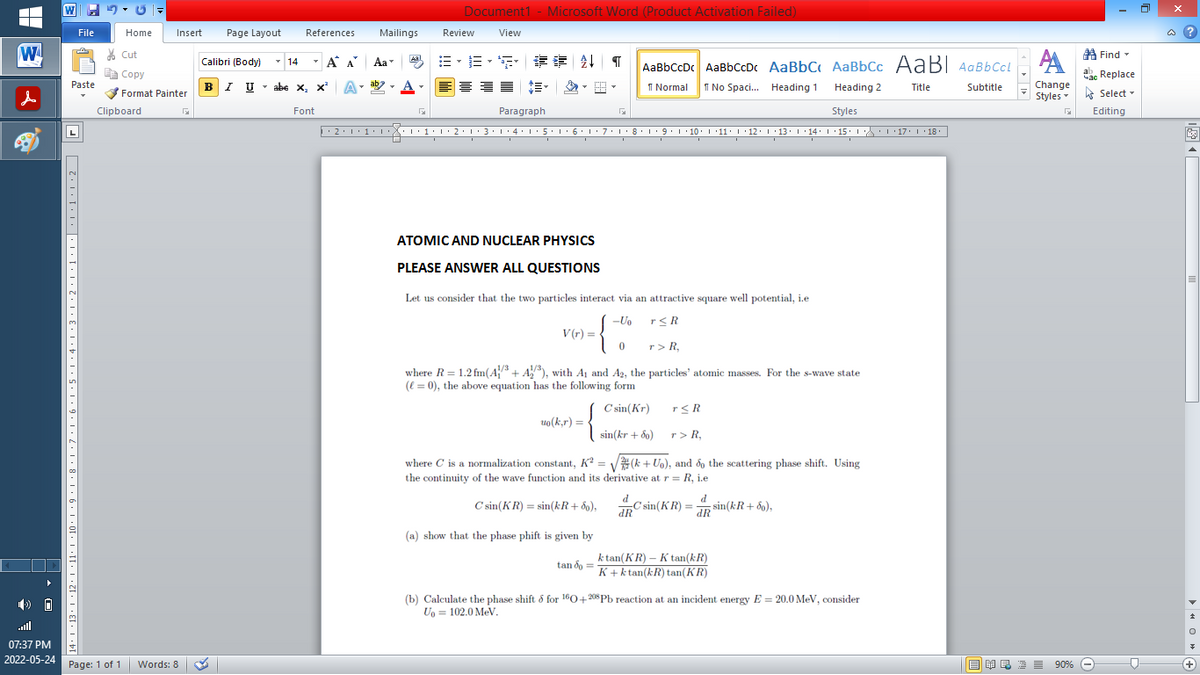ATOMIC AND NUCLEAR PHYSICS PLEASE ANSWER ALL QUESTIONS Let us consider that the two particles interact via an attractive square well potential, i.e -Uo TSR V(r)= 0 r> R, where R = 1.2 fm(4/³+A), with A1 and A2, the particles' atomic masses. For the s-wave state (= 0), the above equation has the following form Csin(Kr) T≤R to(k,r) == sin(kr +80) r> R₁ where C is a normalization constant, K² = √(k+Uo), and do the scattering phase shift. Using the continuity of the wave function and its derivative at r= R, i.e Csin(KR) = sin(kR+ 8), d dR Csin(KR) = sin(kR+60), d dR (a) show that the phase phift is given by
ATOMIC AND NUCLEAR PHYSICS PLEASE ANSWER ALL QUESTIONS Let us consider that the two particles interact via an attractive square well potential, i.e -Uo TSR V(r)= 0 r> R, where R = 1.2 fm(4/³+A), with A1 and A2, the particles' atomic masses. For the s-wave state (= 0), the above equation has the following form Csin(Kr) T≤R to(k,r) == sin(kr +80) r> R₁ where C is a normalization constant, K² = √(k+Uo), and do the scattering phase shift. Using the continuity of the wave function and its derivative at r= R, i.e Csin(KR) = sin(kR+ 8), d dR Csin(KR) = sin(kR+60), d dR (a) show that the phase phift is given by
Related questions
Question

Transcribed Image Text:|
W
07:37 PM
2022-05-24
W
File
70
Paste
14+1+13+1+12+|+11·10 ·9·1·8·1·7·1·6·1·5·1·4·1·3·1·2·1·1····1·1·20
Home
Insert
Cut
Copy
Format Painter
Clipboard
Page: 1 of 1 Words: 8
Document1 - Microsoft Word (Product Activation Failed)
Page Layout
References
Review
View
T
14
T
Α Α΄
B-B-S ## T
AaBbCcDc AaBbCcDc AaBbC AaBbCc AaBl AaBbCcl
abe X, X² A
ab
T
트플
1 Normal No Spaci... Heading 1
Heading 2
Title
Subtitle
Font
Paragraph
G
Styles
··2·1·1·1···1·1·2·1·3·1·4·1·5· 1 · 6 · 1 · 7 · 1 · 8 · 1 · 9 · 1 · 10 · |··11· |·12·|·13°||·14° | ・15° |-·\\ · |·17· |-•· 18 · |
I
I
I
I
I
ATOMIC AND NUCLEAR PHYSICS
PLEASE ANSWER ALL QUESTIONS
Let us consider that the two particles interact via an attractive square well potential, i.e
-Uo
r≤R
V(r) =
{
0
r> R,
1/3
where R = 1.2 fm(4/³ + A/³), with A₁ and A2, the particles' atomic masses. For the s-wave state
(l=0), the above equation has the following form
uo(k,r):
Csin(Kr)
sin(kr + 8)
T≤R
r> R,
where C is a normalization constant, K² = √(k+Uo), and do the scattering phase shift. Using
the continuity of the wave function and its derivative at r = R, i.e
d
Csin(KR) = sin(kR+ 5),
d
dR
-Csin(KR)=
dR sin(kR+60),
(a) show that the phase phift is given by
tan d =
k tan(KR) - K tan(kR)
K+ k tan(kR) tan(KR)
(b) Calculate the phase shift 6 for 160+208 Pb reaction at an incident energy E = 20.0 MeV, consider
Uo 102.0 MeV.
Calibri (Body)
BIU
I U abe X₂ X²
Mailings
Aal
Aa
יד
Ef
Find
A
Час Replace
Change
Styles Select
G
Editing
R 90% Ⓒ
@?
E
OG
Expert Solution
This question has been solved!
Explore an expertly crafted, step-by-step solution for a thorough understanding of key concepts.
Step by step
Solved in 3 steps with 2 images
